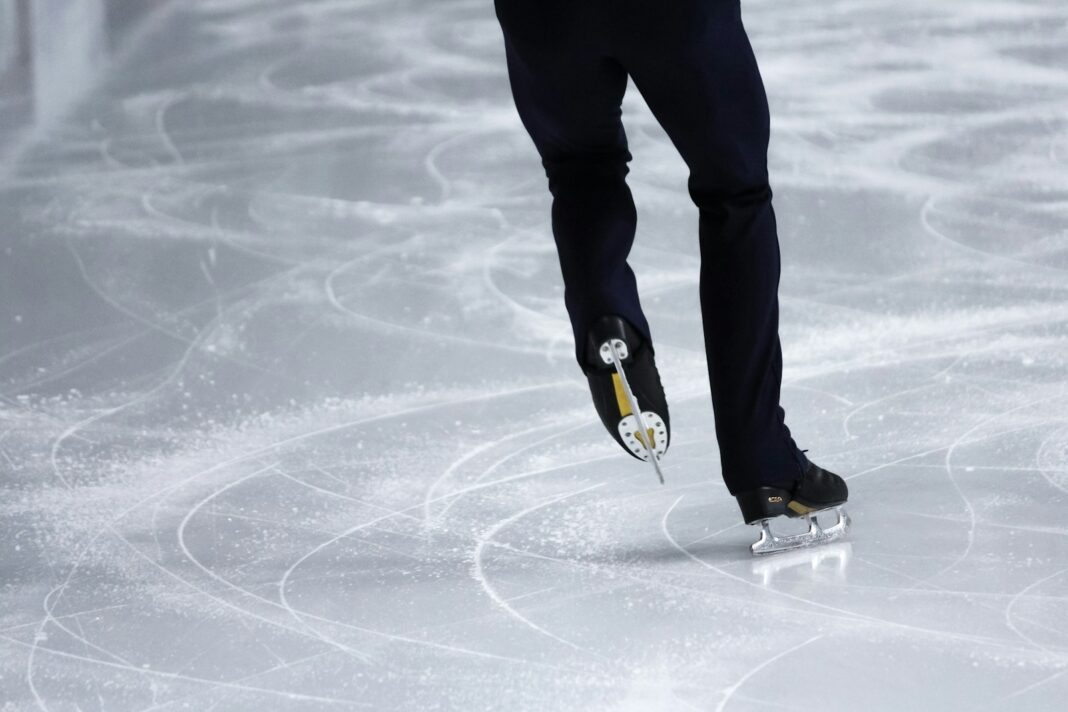Introduction to Ice Skates
Ice skates are specialized footwear equipped with metal blades, designed to glide across ice surfaces. These blades allow for smooth movement and control, making ice skating a unique and exhilarating experience. The origins of ice skating can be traced back thousands of years to Scandinavia, where early skaters used animal bones to glide over frozen lakes and rivers. Over the centuries, ice skates have evolved dramatically, with advances in materials and design enhancing both performance and comfort.
Different Types of Ice Skates
The type of ice skate you choose greatly depends on your skating activity. Each type is designed with specific features to optimize performance in its respective domain.
Figure Skates
Figure skates are designed for figure skating, a sport known for its emphasis on precision, grace, and artistic expression. These skates feature high, stiff boots that provide the necessary support for jumps, spins, and other complex maneuvers. The blades on figure skates are unique, with a slight curve (rocker) and toe picks at the front. These toe picks are essential for performing jumps and other technical movements, giving figure skaters the control they need on the ice.
Hockey Skates
Hockey skates are built for the fast-paced, physically demanding sport of ice hockey. These skates are designed for speed, agility, and durability. The boots are typically shorter and more rigid than those of figure skates, offering protection against impact while allowing quick, sharp turns. The blades on hockey skates are slightly curved and do not have toe picks, as they are designed for rapid movement and sudden stops rather than jumps.
Recreational Skates
Recreational skates are ideal for casual skaters who enjoy ice skating as a leisure activity. These skates prioritize comfort and ease of use, making them perfect for beginners and those who skate occasionally. The boots are often padded and may have easy-to-use fastening systems such as buckles or Velcro straps. The blades on recreational skates are generally flatter, providing greater stability for those still mastering their balance on the ice.
Speed Skates
Speed skates are designed for one thing: speed. Used in competitive racing, these skates feature long, flat blades that maximize glide and reduce friction on the ice. The boots are low-cut, allowing for greater ankle flexibility, which is crucial for maintaining speed. Unlike other types of skates, the blades on speed skates extend beyond the toe and heel of the boot, providing more surface area for powerful, sustained strides.
Key Components of Ice Skates
Ice skates are composed of several essential parts, each contributing to the skater’s performance and comfort.
Boots
The boot is the most prominent part of an ice skate, responsible for providing support and protection to the skater’s feet and ankles. The materials used for the boot vary depending on the type of skate. Leather is commonly used in figure skate boots for its durability and ability to mold to the skater’s foot. Hockey skates, on the other hand, often use synthetic materials that offer both protection and flexibility.
Blades
The blade is the part of the skate that makes contact with the ice, allowing the skater to glide smoothly. Blades are usually made from high-carbon steel, which is durable and capable of holding a sharp edge. The design of the blade—its length, thickness, and curvature—varies depending on the type of skate and the activity it’s intended for. Regular maintenance, such as sharpening, is crucial to keep the blades in top condition.
Blade Holders
Blade holders, also known as chassis or frames, are the structures that connect the blades to the boots. They are typically made from lightweight, durable materials such as plastic or composite. The design of blade holders varies depending on the skate type; for example, hockey skate holders are built to withstand the impact of the game, while figure skate holders focus on stability and precision.
Toe Picks
Toe picks are a distinctive feature of figure skates, consisting of jagged edges at the front of the blade. These picks play a critical role in figure skating, enabling skaters to perform jumps, spins, and intricate footwork. While essential for figure skaters, toe picks are absent in other types of skates, where they would hinder performance rather than help it.
Choosing the Right Ice Skates
Selecting the perfect pair of ice skates requires careful consideration of several factors, including your skating goals, foot size, and blade type.
Identifying Your Skating Goals
The first step in choosing the right skates is determining your primary use. Are you interested in figure skating, hockey, speed skating, or simply enjoying a leisurely skate? Your answer will guide you in selecting the appropriate type of skates that cater to your specific needs.
Finding the Right Fit
A well-fitted pair of skates is crucial for both performance and comfort. Ice skates should fit snugly, with minimal wiggle room for your feet. Too much movement inside the boot can lead to blisters, discomfort, and reduced control on the ice. It’s important to try on skates while wearing the same type of socks you plan to use during skating. If possible, walk around in the skates to ensure they provide adequate support and comfort.
Choosing the Correct Blade
The type of blade is just as important as the boot itself. Different activities require different blade characteristics. For example, figure skating blades are curved and have toe picks, while hockey blades are designed for quick stops and rapid direction changes. Speed skating blades, which are longer and flatter, are optimized for minimizing friction and maximizing glide.
Ice Skating Techniques
Whether you’re a beginner or a seasoned skater, mastering the right techniques is essential for improving your performance on the ice.
Basic Skating Techniques
For beginners, the first step is learning how to maintain balance on the ice. Start by practicing basic gliding, focusing on keeping your knees slightly bent and your weight centered over the blades. Once you’re comfortable, you can move on to more advanced techniques like turning and stopping. A popular stopping technique for beginners is the “snowplow stop,” where you push the edges of your skates outwards to create friction and come to a gradual halt.
Advanced Figure Skating Techniques
Figure skating is a sport of precision and artistry, with advanced techniques that require skill and practice. Spins, such as the scratch spin, involve rotating rapidly on one foot, while jumps like the axel require powerful take-offs and precise landings. Footwork sequences, which involve intricate steps and turns, add complexity and flair to figure skating routines.
Hockey Skating Techniques
Hockey skating focuses on speed, agility, and power. Key techniques include the hockey stop, which allows players to come to a rapid halt by turning their skates sideways, and crossovers, which enable tight turns and quick changes in direction. Backward skating is also a fundamental skill for defense, allowing players to maintain speed and control while moving in reverse.
Maintaining Your Ice Skates
To ensure your ice skates remain in top condition, regular maintenance is essential. Proper care not only extends the life of your skates but also enhances your performance on the ice.
Cleaning and Drying Your Skates
After each use, it’s important to wipe down your skates, particularly the blades, to remove any moisture and prevent rusting. Using a soft cloth, dry the blades thoroughly before storing the skates. Additionally, the boots should be dried properly to prevent odors and the growth of mold, especially if they are made from leather.
Regular Blade Sharpening
The sharpness of your blades directly affects your ability to skate smoothly and execute precise maneuvers. Dull blades can lead to poor performance and increased risk of injury. It’s recommended to have your blades professionally sharpened after every 20 to 30 hours of use, depending on how often you skate and the conditions of the ice.
Proper Storage
When not in use, store your skates in a cool, dry place to prevent damage. Avoid exposing them to extreme temperatures, which can cause materials to degrade. To protect the blades, use blade guards when storing your skates, and consider using soft soakers to absorb any remaining moisture.
Common Ice Skate Issues and Solutions
Like any equipment, ice skates can develop issues over time. Identifying and addressing these problems early can prevent them from becoming serious.
Blade Dulling
One of the most common issues skaters face is dull blades. This can happen gradually as the blades come into contact with the ice and other surfaces. Dull blades reduce your ability to glide smoothly and make it difficult to perform certain movements. Regular sharpening is the best way to prevent this issue and ensure consistent performance.
Boot Discomfort
Discomfort in the boots can be a result of poor fit, improper break-in, or worn-out padding. If you experience pain or blisters, it may be time to reassess the fit of your skates. Sometimes, custom insoles or additional padding can alleviate discomfort and improve the overall fit.
Loose Blade Holders
Loose blade holders can lead to instability and affect your performance on the ice. If you notice any wobbling or movement of the blades, it’s important to check the screws or rivets that secure the holders to the boots. Tightening them may solve the issue, but in some cases, you may need to replace the holders entirely.
Safety Tips for Ice Skating
Ice skating is a fun and rewarding activity, but safety should always be a top priority to prevent injuries.
Wearing Protective Gear
Protective gear is especially important for beginners and those participating in high-impact activities like hockey. Helmets, knee pads, elbow pads, and wrist guards can help protect you from serious injuries in case of falls or collisions.
Proper Warm-Up and Stretching
Before stepping onto the ice, it’s essential to warm up and stretch your muscles. A proper warm-up routine helps prepare your body for the physical demands of skating, reducing the risk of strains and injuries. Stretching your legs, ankles, and lower back can improve flexibility and performance.
Being Aware of Ice Conditions
Understanding the conditions of the ice is crucial for safe skating. Check for any cracks, bumps, or debris that could cause you to trip or fall. If you’re skating outdoors, be mindful of weather changes that can affect the quality and safety of the ice.
Environmental Impact of Ice Skates
While ice skating is a relatively low-impact sport, the production and disposal of ice skates can have environmental implications. However, there are efforts within the industry to minimize this impact.
Using Sustainable Materials
Some manufacturers are increasingly turning to sustainable materials for ice skate production. These include recycled plastics, organic textiles, and responsibly sourced leather. Choosing skates made from sustainable materials can help reduce the environmental footprint associated with your equipment.
Adopting Eco-friendly Manufacturing Practices
In addition to using sustainable materials, some companies are adopting eco-friendly manufacturing practices. These practices might include reducing waste, conserving energy, and using non-toxic adhesives. By supporting brands that prioritize environmental responsibility, you can contribute to a more sustainable future for ice skating.
Notable Ice Skaters and Their Skates
Throughout history, many ice skaters have achieved greatness, often relying on their trusted skates to help them reach new heights in their sport.
Conclusion
Ice skates are an indispensable tool for anyone looking to explore the world of ice skating, whether for recreation or competition. By choosing the right pair of skates, practicing consistently, and prioritizing safety, you can enjoy the many benefits of ice skating for years to come.












